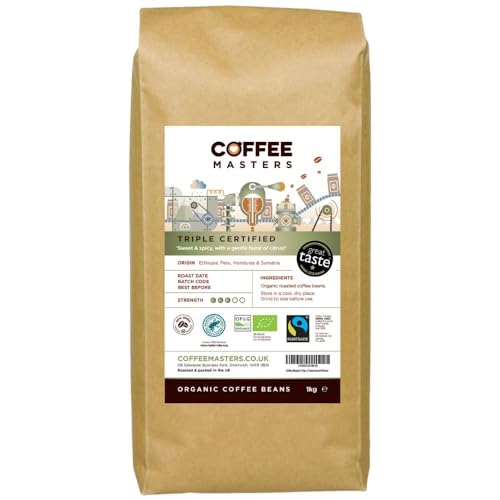The Benefits and Side Effects of Coffee Beans
Coffee beans are awash with health benefits. They can boost cognitive function and reduce the risk of developing heart disease. However, consuming too many beans can cause side effects like anxiety and sleep issues.
The taste of coffee can differ based on the location, elevation and cultivation techniques. The species of the plant can also affect the taste.
Origin
Coffee beans are the seeds of a tropical evergreen tree. The beans are then roasted, then ground to produce the most popular coffee beverage in the world. Coffee is the world's third most popular beverage and one of the most profitable commodities. It is renowned for its invigorating effect, caused by the alkaloid caffeine.
The most widely-respected origin story for coffee is that of an Abyssinian herder of goats known as Kaldi. He noticed his animals were more energetic after eating berries of certain plants. He experimented with the berries himself and found them to be stimulant, so he set about cultivating the plant, and then making coffee.
In the 16th century the coffee was transported eastwards to the Arabian Peninsula where it was grown on the Yemeni peninsula. It grew further and the first coffee houses were opened. These meeting places were diametrically different from the taverns of Europe and centered on fast-paced and deep thinking.
The majority of the coffee that is produced today is derived from two distinct kinds of plants known as Arabica and Robusta. They grow best in the Bean Belt region which is a strip of land that lies between the Tropic of Cancer & Capricorn.
Types
There are many different types of coffee beans, and each type is distinct in its flavor profile. The regions in which the beans are grown have a significant influence on their flavors. Ethiopian coffee, for example is famous for its citrus and floral notes, while Colombian beans have a full-bodied acidity and an acidity that is balanced.
Coffee beans are harvested in various ways and are refined to enhance their flavor. Some are dried before being roasted, whereas others are frozen before being ground later. Depulping involves polishing beans to remove silvery skin. The beans are then sorted and graded by size and weight, and any imperfections are removed either by hand or by machines.
As opposed to coffeebeans , Robusta plants can grow at lower altitudes, and they are more resistant to pests. They also have more caffeine than Arabica beans, and are used primarily in blends or instant coffees. However more and more coffee lovers are enjoying the distinctive flavor and high quality of single origin coffees.
Flavor
Coffee beans can be infused with a variety flavors that add new dimension to desserts, drinks and food recipes. The right kind of bean for a recipe is determined by the desired flavor profile and the way the recipe is to be served.
The coffee bean is a plant that is a source of pollysaccharides as well as other proteins, sugars, lipids, and minerals. The seed is protected by silverskin, which is removed during roasting. When the seeds are exposed to heat and pressure, they initiate an ensuing series of reactions that create their flavor, aroma and color.
Coffee purists believe that the natural flavors of coffee are the top-quality. However, it is also possible to add flavor to roasted coffee beans using manufactured flavors. To enhance the flavor of a batch, the roaster sprays flavored oil onto the beans. The flavored oil is added to the beans until it's evenly distributed. The beans are then cool, ground, and then packaged. The flavored coffee beans can be used to make an iced cup of flavored coffee or they can be consumed as a snack, without being brewed.
Health benefits
Coffee beans are a source of caffeine, which is a powerful stimulant that can boost energy and improve mood. They also contain phenolics which are antioxidants and help protect cells from damage. These compounds have been linked with a decreased risk of heart cancer and other diseases, according to the National Institutes of Health.
The coffee seeds plant are located inside a fruit which looks like an apple. Generally, the fruit contains two seeds that are on top of each other. Certain fruits only contain one seed. They are referred to as peaberries. Peaberries yield a weaker, less flavorful cup of coffee.
Roasting coffee beans changes their flavor and makes them more appealing to the taste buds. Roasting coffee beans makes them easier to digest by the body.

Coffee beans contain phenolic substances that inhibit glucose formation in the liver and reduce cholesterol levels. They can also lower the risk of nonalcoholic fatty cirrhosis and non-alcoholic liver disease. Coffee beans are rich in potassium and riboflavin, as well as B vitamins, and fiber.
Side effects
Coffee seeds are roasted and blended into a drink that is popular. Coffee consumption is linked to a decreased chance of developing type 2 diabetes and liver disease. Caffeine in brewed coffee may cause side effects, such as heartburn, jitters, and high blood pressure for certain people. Green coffee bean extract is a caffeine-free option that has shown to have many of the same benefits as brewed coffee without the negative side effects.
Coffee beans contain a number of nonvolatile and volatile chemicals which protect them from insects, oxidation, and other diseases. These chemicals also enhance their flavor. Nonvolatile compounds create waxy layers on the surface of coffee beans. This cover-up deters many insects from eating coffee beans and assists the beans retain moisture.
The fatty acids found in coffee beans are converted into energy when the beans are roasted. This energy can boost mental performance. It also stimulates the release of adrenaline, which is a hormone that prepares the body for physical exertion. The chlorogenic acid found in green coffee beans may also lower fat absorption and slow the release of sugar from the digestive system.
